The 17 works of art you need to see in L.A. County
We tend to rank art museums according to the importance of their permanent collections, even as those rooms likewise tend to be the quietest, less-traveled spaces in the building. “What’s new?” we ask ourselves as we make a beeline to the special exhibition galleries to see the latest offering.
In truth, nothing makes me happier than spending time in those quieter galleries where objects in the collection become like friends you’re happy to run into again. The experience is how one develops a special bond with a museum, which can otherwise feel institutionally aloof. Lunch at the cafe or sale-shopping at the store can be a fun diversion, but extra time with the collection is finally more satisfying.
Temporary, changing exhibitions draw most of the attention at Los Angeles art museums, as they do everywhere, but together the city’s museums hold hundreds of thousands of absorbing works of global art in their collections. Here are some examples, selected not because they represent the cream (though some do) but because aesthetic value spreads wide and the major and the minor have their own charms. Each is something I find myself returning to, so the more time one spends, the more they reveal themselves.
Not all museums have permanent permanent-collection displays, however, instead changing what’s on view from the collection with regularity; others have only modest gallery space for it. So before you go it’s often worth checking the institution’s website if you hope to see a specific object.

Sabato Rodia began assembling Watts Towers a century ago.
(Carolyn Cole/Los Angeles Times)
Sabato Rodia, “Nuestro Pueblo (Watts Towers),” 1921-1954, mixed media
The visionary “sailing ship” of 17 lacy towers, the tallest reaching almost 100 feet into the sky, is one of the earliest masterpieces of 20th century American art and the first to be made in Los Angeles. Sabato Rodia, a working-class immigrant untrained in art, encrusted the towers with bits of seashells, broken soda bottles and ceramic shards. Castoffs become consecrations.
Watts Towers Art Center, 1727 E. 107th St., 90002
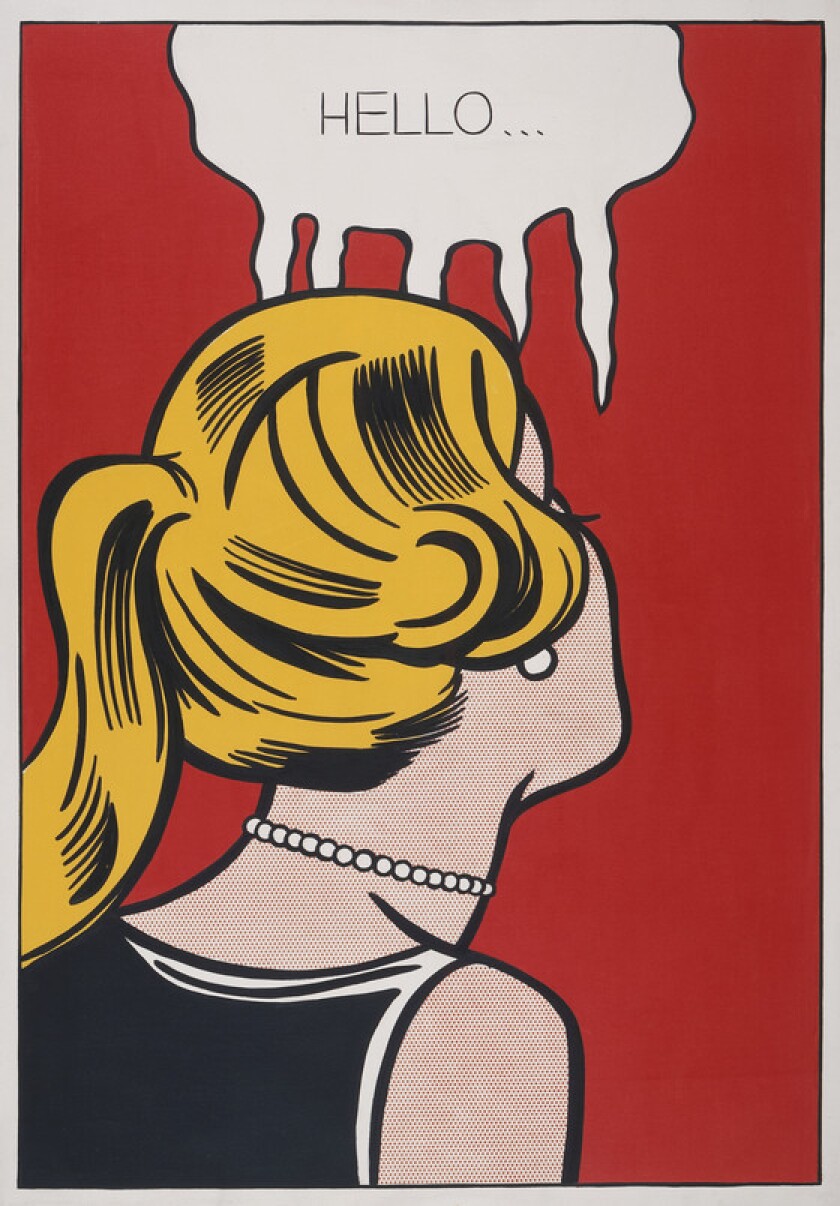
Roy Lichtenstein, “Cold Shoulder,” 1963, oil and Magna on canvas
(© Estate of Roy Lichtenstein)
Roy Lichtenstein, “Cold Shoulder,” 1963, oil and magna on canvas
A fervent fight was underway in New York School painting as the 1950s arrived: Who was the greater artist paving the way — Willem de Kooning, post-Cubist master of the graceful fluid line, painting from his wrist, or Jackson Pollock, athletically drip-painting from his shoulder to put his whole body into it? Roy Lichtenstein, summoning trademark wit through a deftly chosen comic book image carefully rendered, gave the cold shoulder to the big, macho, abstract gesture. Icily turning his back on it, he had me at hello.
Los Angeles County Museum of Art, 5905 Wilshire Blvd., 90036

Charles Dickson, “Wishing on a Star,” 2009, recycled metal and repurposed objects
(Christopher Knight/Los Angeles Times)
Charles Dickson, “Wishing on a Star,” 2009, recycled metal and repurposed objects
Remember dowsing — sometimes called divining? The Y-shaped dowsing/divining rod held up to the sky in Charles Dickson’s sculpture located outside of the California African American Museum aims to locate a starburst of imagination, rather than water, gemstones or other buried treasures. The striding figure, composed from bent rebar and bits of electronic equipment embedded within the structure, is dressed in a space suit complete with helmet and bulky backpack. Appropriately, given the task, Dickson’s fanciful star voyager is larger than life.
California African American Museum, Exposition Park, 600 State Drive, 90037
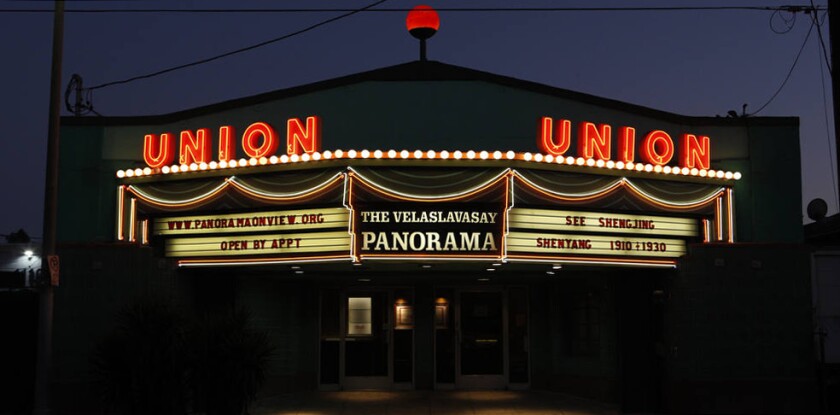
Li Wu, Yan Yang, Zhou Fuxian and a Los Angeles team of artists, “The Shengjing Panorama,” installed 2019, mixed media
Before there was digital immersive art, there were 360-degree panorama paintings that wrapped all the way around the room, popular entertainments in the late-18th and 19th centuries. This imaginative extravaganza, complete with sound and lighting, puts a viewer inside a nostalgic, century-old depiction of Shengjing, a “lost” Chinese city, former home to Manchu emperors and today a modern steel-and-glass metropolis. You’re inserted betwixt-and-between in time and space.
The Velaslavasay Panorama, 1122 W. 24th St., 90007
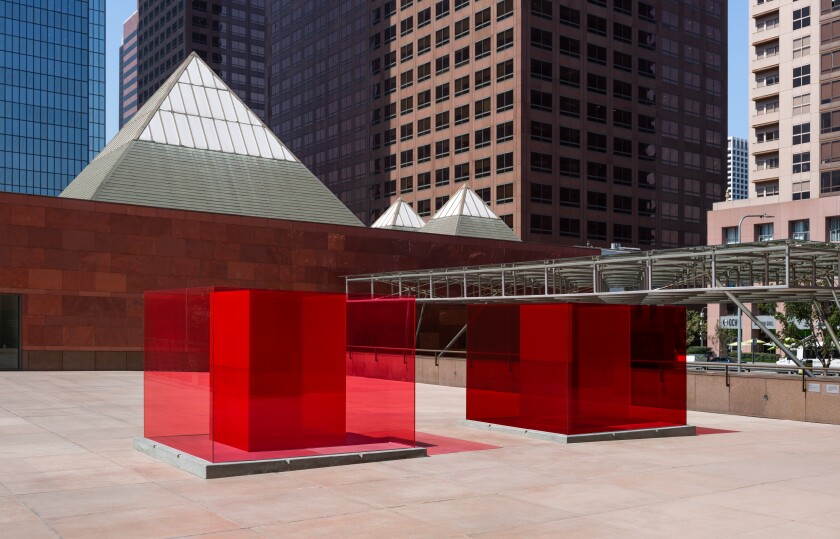
Larry Bell, “Bill and Coo at MOCA’s Nest,” 2019, laminated glass
(Museum of Contemporary Art)
Larry Bell, “Bill and Coo at MOCA’s Nest,” 2019, laminated glass
This pair of identical, human-size crimson sculptures of rectangular glass boxes nestled inside bigger rectangular glass boxes can make you perceptually dizzy as you try to figure out what you’re seeing. How? The technical term for each cherry red form is an orthotope, defined as “the Cartesian product of orthogonal intervals known as a hyperrectangle, sometimes called a parallelotope.” (You were warned.) Now multiply that times two — one for each eye.
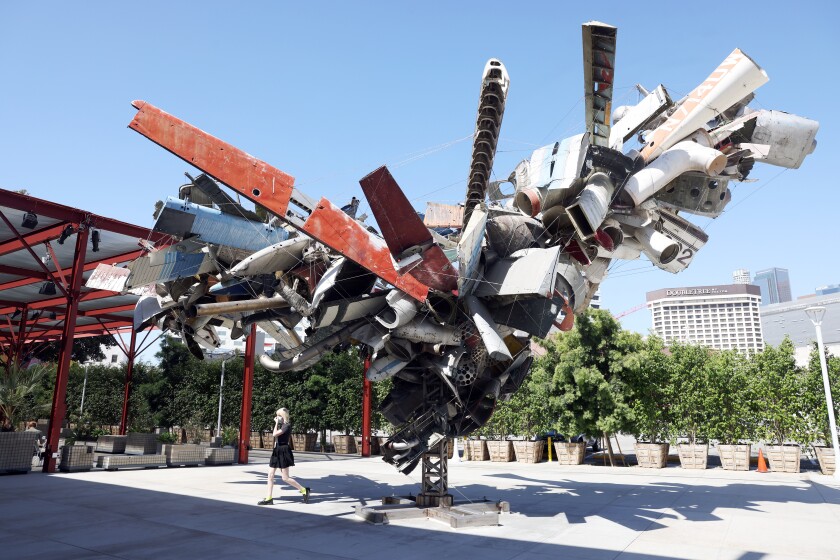
Los Angeles, CA – May 13: Nancy Rubin’s 25-foot-high and 50-foot-wide sculpture made from airplane parts that are wired together is on display in front of the Geffen Contemporary at the Museum of Contemporary Art in Little Tokyo.
(Dania Maxwell/Los Angeles Times)
Nancy Rubins, “Chas’ Stainless Steel, Mark Thompson’s Airplane Parts, About 1,000 Pounds of Stainless Steel Wire, and Gagosian’s Beverly Hills Space at MOCA,” 2001, stainless steel and airplane parts
A towering, 25-foot-tall “tree of life” is rigorously erected from assembled industrial waste, its shape determined by the gallery dimensions where it was first shown more than two decades ago. The huge plaza sculpture is at once an improbable engineering marvel and a rusted-out rebuke to modern environmental devastation.
Museum of Contemporary Art, 250 S. Grand Ave. (Bell), and Geffen Contemporary at MOCA, 152 N. Central Ave. (Rubins), 90012
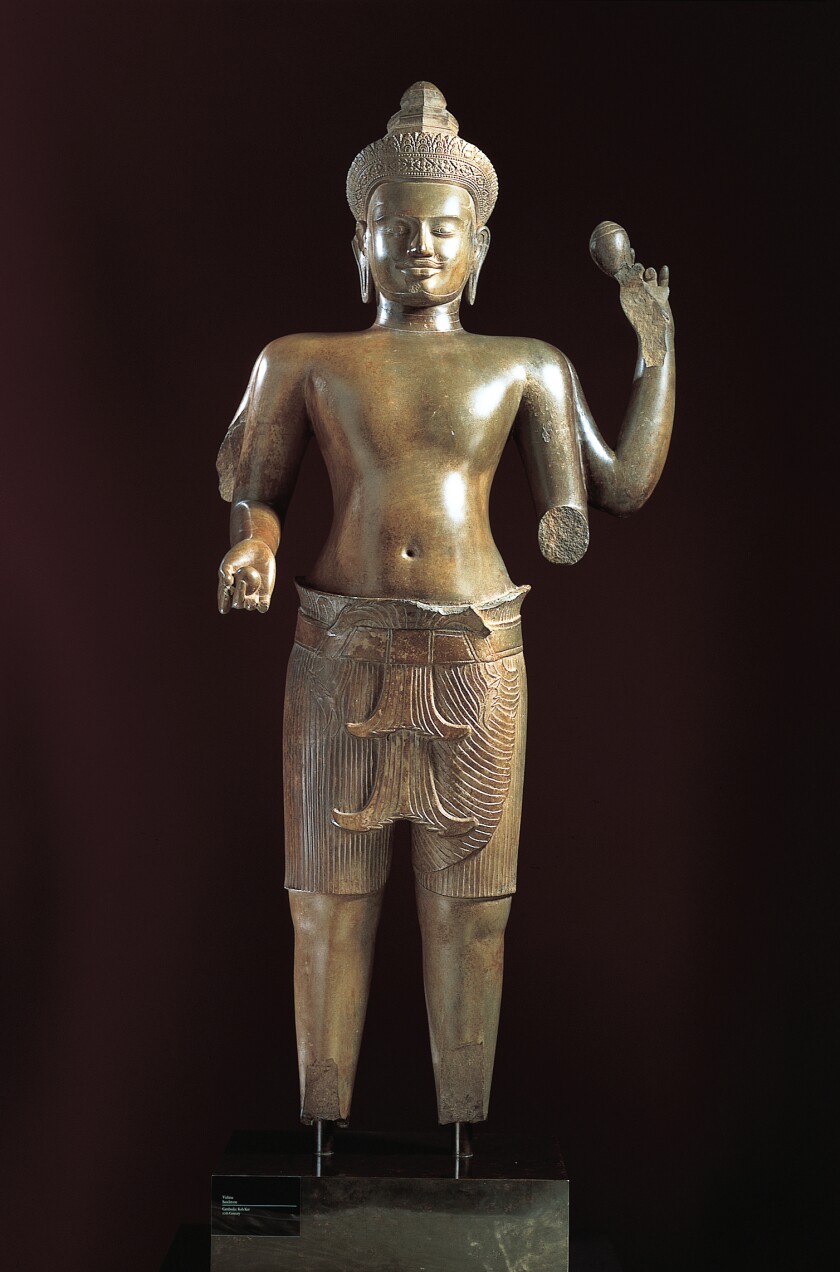
Cambodia: Angkor period, “Vishnu,” c. 950, Sandstone
(Norton Simon Art Foundation)
Cambodia: Angkor period, “Vishnu,” circa 950, sandstone
In the Hindu trinity, Brahma is the creator and Shiva the destroyer, but Vishnu occupies a special place as preserver of the world. In this unusual sculpture made of highly polished rather than smooth, matte sandstone, a columnar, stable figure lifts a conch shell in preparation for giving a mighty blast, meant to ward off demons. Given the precarious state of the world, we could use some help from sturdy Vishnu right about now.
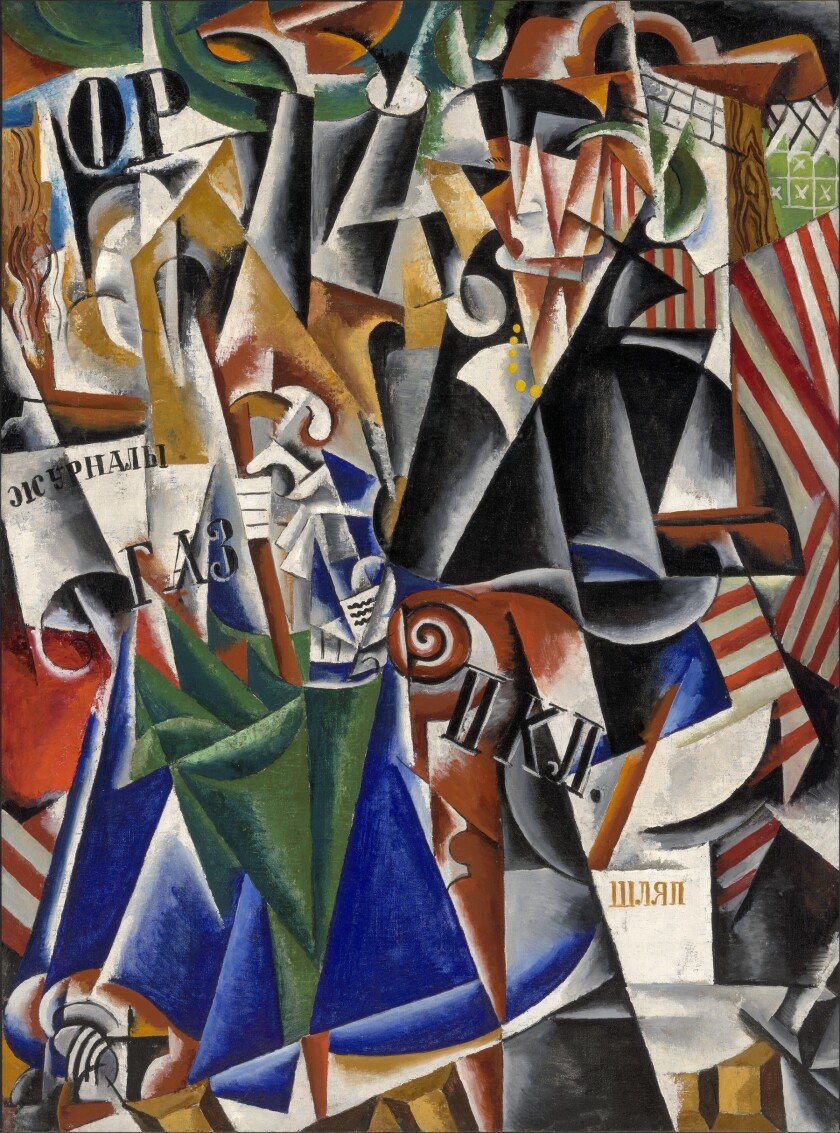
A Cubist painting of a woman featuring Cyrillic lettering
(Norton Simon Art Foundation)
Liubov Popova, “The Traveler,” 1915, oil on canvas
The great Russian painter, who lived and worked in Moscow but traveled 1,700 miles to study in the period’s boisterous Parisian art milieu, depicted the experience of riding in the second-class compartment of a train, green umbrella in one hand and newspaper clutched in the other. Popova’s vivid colors and shattered Cubist structure create an optical equivalent for the jumpy motion of the ride.
Norton Simon Museum, 411 W. Colorado Blvd., Pasadena, 91105
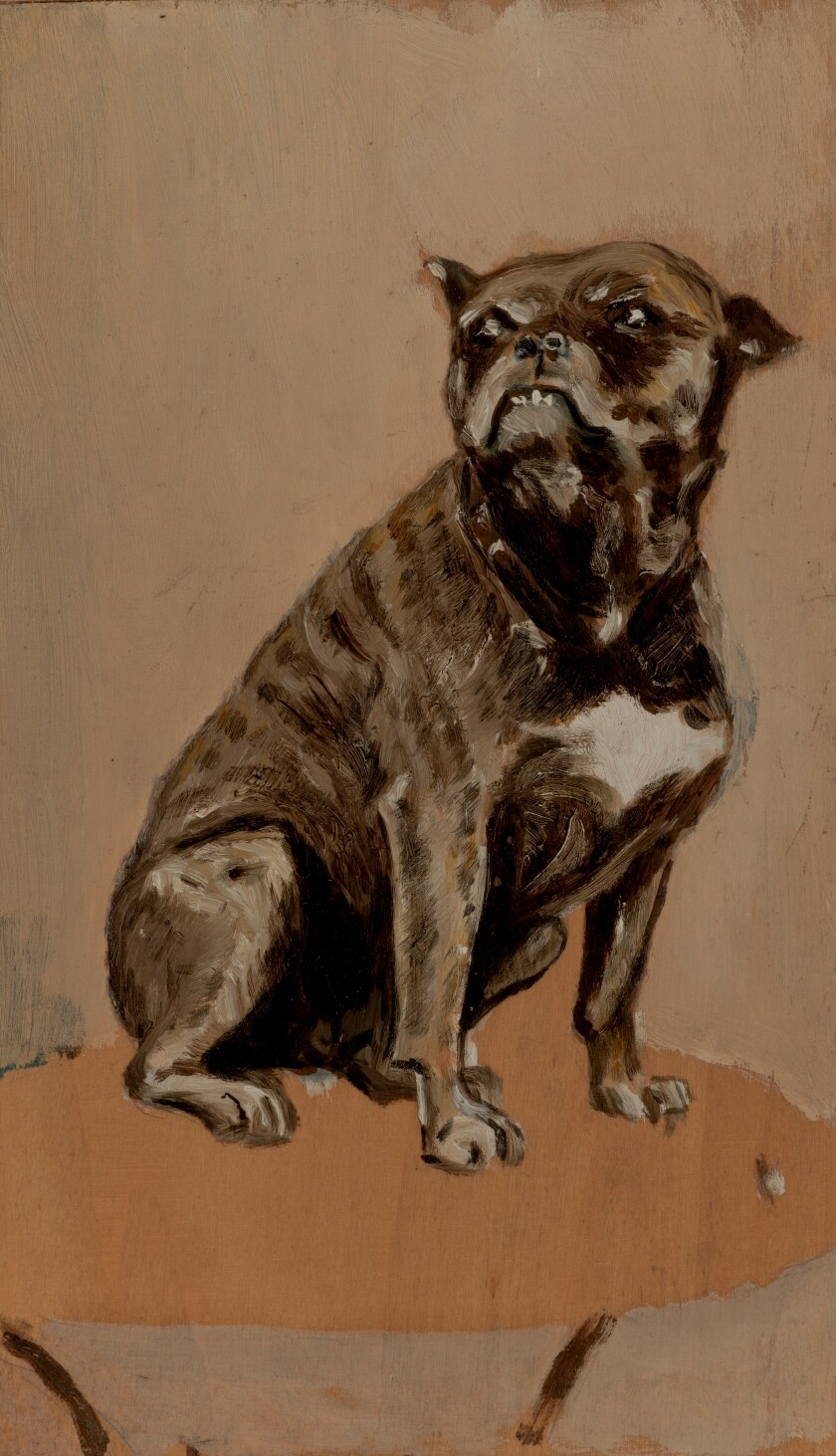
Henri de Toulouse-Lautrec, “Touc, Seated on a Table,” circa 1879-1881, oil on panel
(UCLA Hammer Museum)
Henri de Toulouse-Lautrec, “Touc, Seated on a Table,” circa 1879-1881, oil on panel
As portrait paintings go, this one is a dog. The Parisian pup’s name is Touc, and Henri de Toulouse-Lautrec, denizen of bohemian nightlife, has set the chunky brindle, black and white dog (a bull terrier?) atop a cafe table as a stage for the portrait sitting. Touc grins and casts a sideways glance at an unseen person or happening just outside the frame, alert and ready to join in. The artist, known for lively pictures of cabaret personalities who exude a fierce sense of theatrical self-possession, extends the range to include a best-friend icon of the urban animal world.

John Singer Sargent, “Dr. Pozzi at Home,” 1881, oil on canvas
(UCLA Hammer Museum)
John Singer Sargent, “Dr. Pozzi at Home,” 1881, oil on canvas
The miracle of science is cloaked in the elevated trappings of religious faith in this elegant full-length portrait. American expat painter John Singer Sargent drapes Samuel-Jean Pozzi, a Parisian gynecologist and surgeon, in crimson robes fit for a Vatican cardinal. (Pozzi’s father was a Protestant minister.) His mannered but gracefully posed hands perhaps indicate the delicacy required for surgical prowess, as well as his nonprofessional demeanor as an art-collecting aesthete. Just 35 when Sargent painted him, the handsome doctor was murdered at 72 by an unhappy patient.
UCLA Hammer Museum, 10899 Wilshire Blvd., 90024
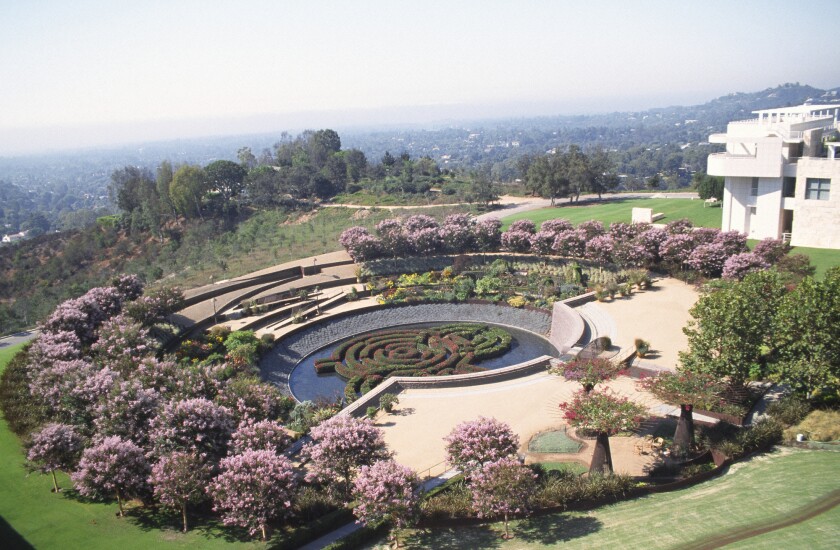
Robert Irwin, “Getty Central Garden,” 1997, mixed media (construction and plant materials)
(J. Paul Getty Museum)
Robert Irwin, “Central Garden,” 1997, mixed media (construction and plant materials)
Robert Irwin’s immersive environmental sculpture zigzags its way down a recirculating stream in a shallow ravine, surreptitiously leading a visitor on a lushly planted path that finally winds its way around an oval pool hosting an azalea maze. Your back now turned to the stunning vista opening out over the Pacific from the Getty Center’s hilltop site, you look back and up the hill to the path you’ve taken, framed by an art museum to the right and a research library to the left. Perfect.

Luisa Roldan, “Saint Ginés de la Jara,” circa 1692 (polychromer: Tomás de los Arcos); wood, paint and mixed media
(J. Paul Getty Museum)
Luisa Roldán, “Saint Ginés de la Jara,” circa 1692, polychromed wood with glass eyes
Working with her brother-in-law, Tomás de los Arcos, who fabricated the brocaded ecclesiastical garments incised with gold, Luisa Roldán made a startlingly lifelike, hyperreal figure of the preaching saint Ginés de la Jara. Beheaded in France defending his faith, he was said to have then tossed his own head into a river, which carried it to the Mediterranean and back home to Spain. To embody the story of a miracle, La Roldána clearly decided, make the sculpture miraculous.
J. Paul Getty Museum, 1200 Getty Center Drive, 90049
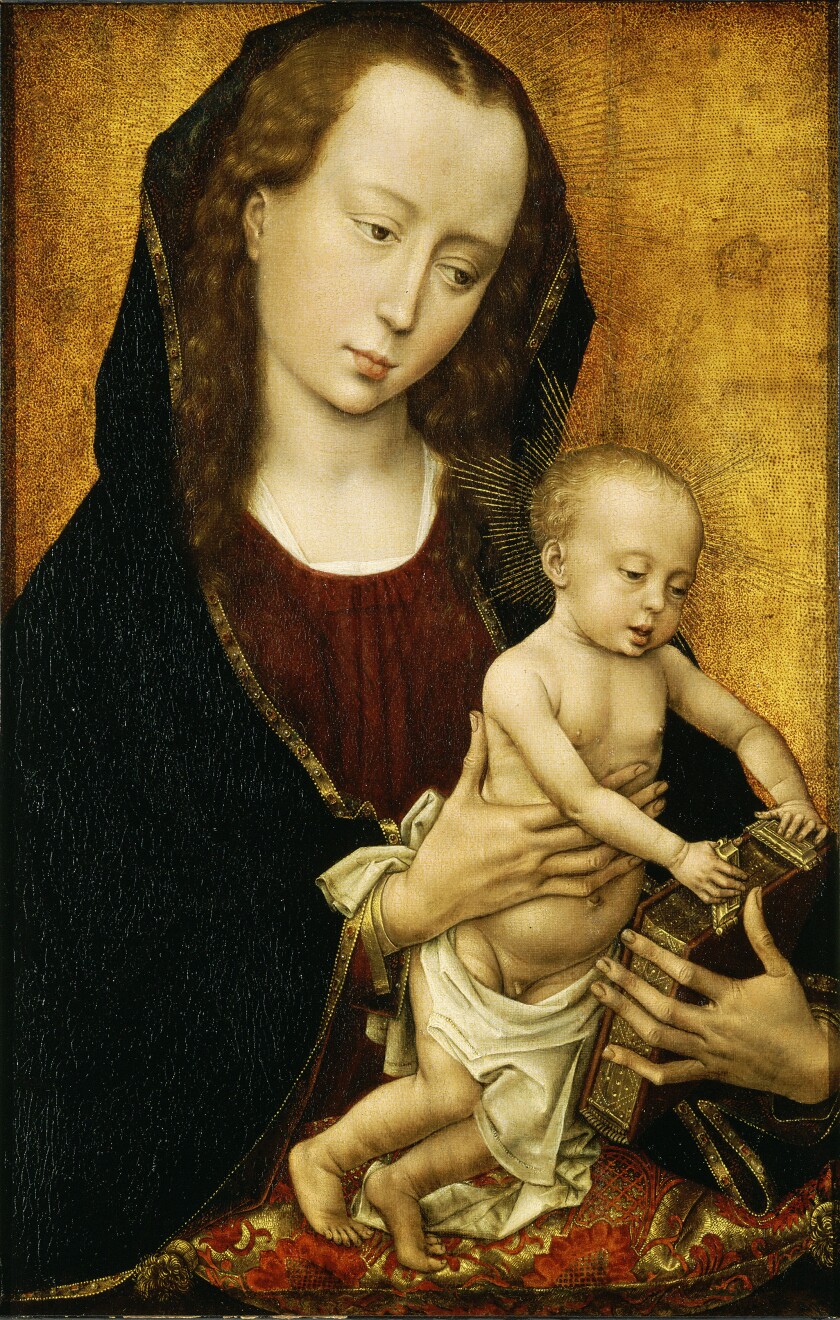
Rogier van der Weyden, “Virgin and Child,” c. 1460, oil on panel
(Huntington Library, Art Museum, and Botanical Gardens. The Arabella D. Huntington Memorial Art Collection
)
Rogier van der Weyden, “Virgin and Child,” circa 1460, oil on panel transferred to canvas
Arguably the finest early Northern Renaissance painting in Los Angeles, the panel shows burbling baby Jesus with a mixed expression — part little old man, signifying worldly wisdom, and part playful infant, toying with the lock on a book that will someday tell a story of Christian salvation. Rogier van der Weyden endows his mom with a look of wistful devotion, as if knowing the personal loss to come.
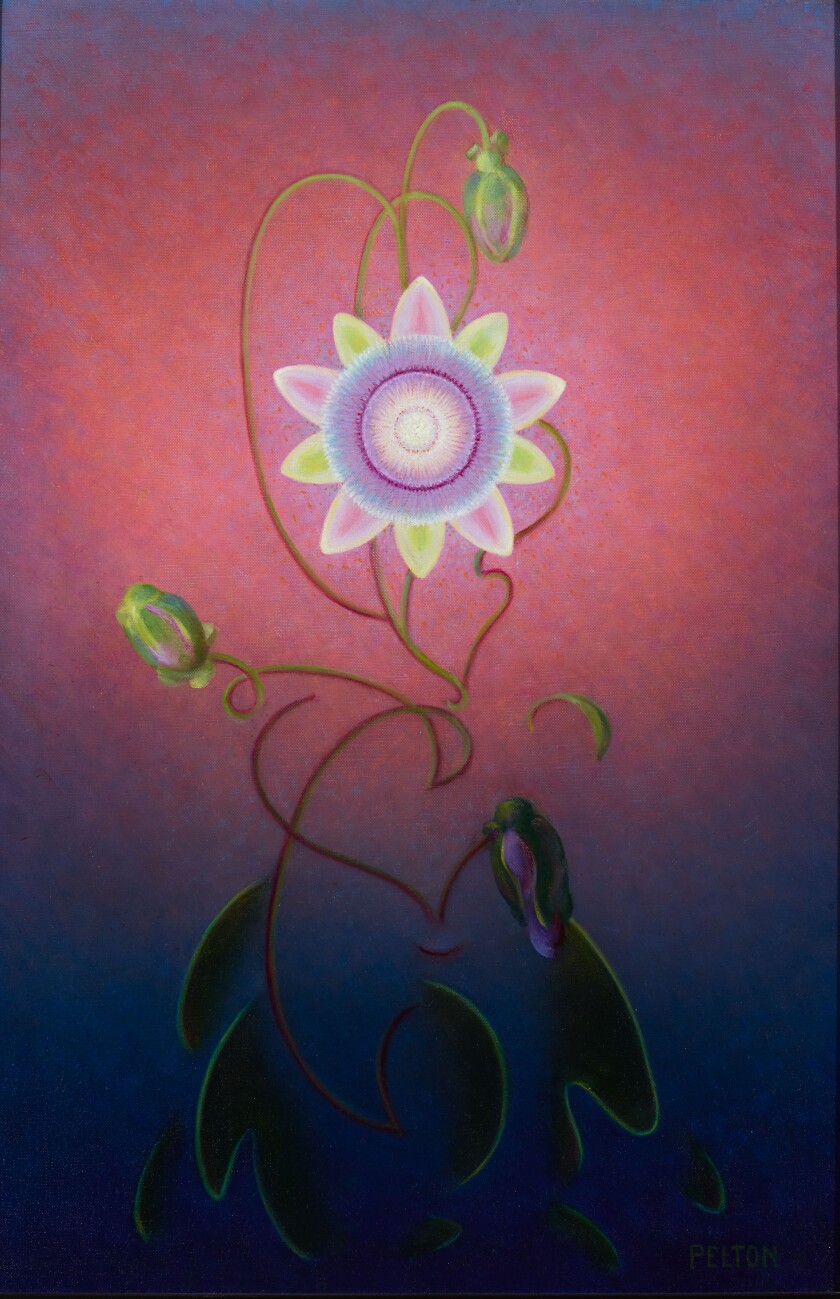
Agnes Pelton, “Passion Flower,” circa 1945, oil on canvas
(Huntington Library, Art Museum, and Botanical Gardens
)
Agnes Pelton, “Passion Flower,” circa 1945, oil on canvas
Thin glazes of gemstone color capture and reflect light from a geometric flower hovering in space, transforming what could have been a conventional floral still life into a spectral talisman. Agnes Pelton lived alone in the tiny Sonoran Desert town of Cathedral City, outside Palm Springs, from 1932 until her death at 80 in 1961, where she fashioned a distinctive Symbolist art that evoked occult and spiritual philosophies, often with an Art Deco edge.
Huntington Library, Art Museum and Botanical Gardens, 1151 Oxford Road, San Marino, 91108
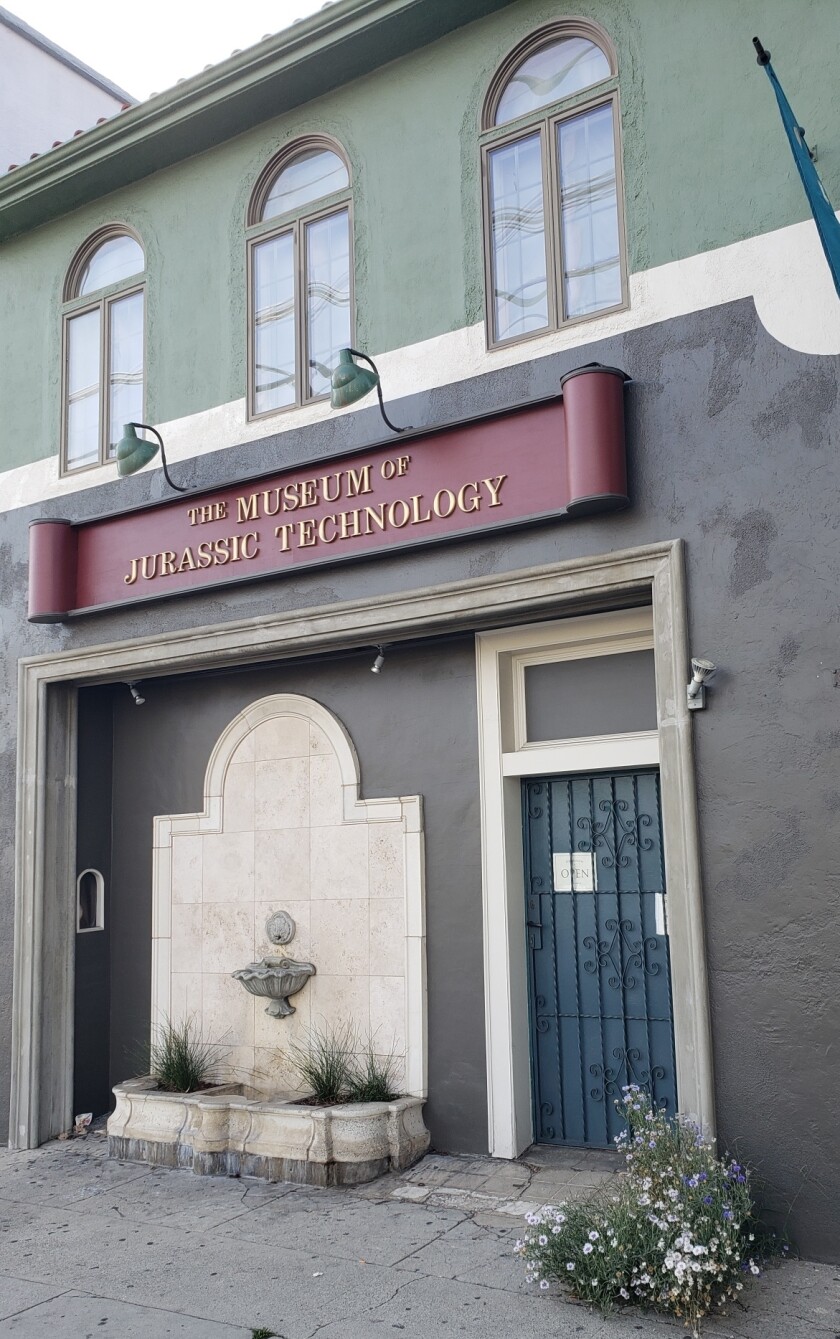
The Museum of Jurassic Technology, itself a celebrated work of art, has been beguiling visitors since 1988.
(Christopher Knight/Los Angeles Times)
David Hildebrand Wilson and Diana Drake Wilson, Museum of Jurassic Technology, est. 1988
A screaming African ant audible to the human ear; microminiature sculptures, no bigger than the head of a pin, carved by an expatriate Egyptian musician; instructions on how to X-ray a rainforest bat — perplexing displays at the Museum of Jurassic Technology, described as of “uncertain and unexplained” meaning, aren’t the only works of art to be seen. The entire storefront museum (including its shop) is itself one big installation by artist David Hildebrand Wilson, who received a MacArthur Fellowship for it in 2001, and Diana Drake Wilson.
Museum of Jurassic Technology, 9341 Venice Blvd., Culver City, 90232
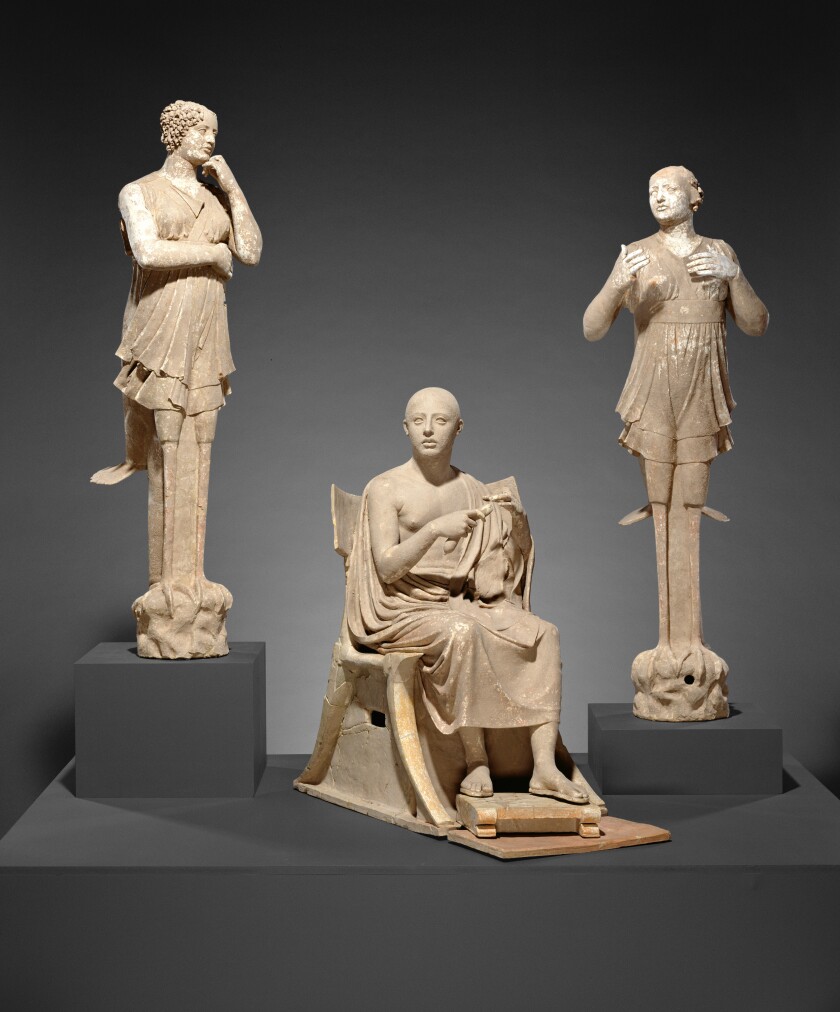
“Sculptural Group of a Seated Poet and Sirens,” Greek, 350–300 BC; terracotta with ploychromy
(J. Paul Getty Museum)
“Sculptural Group of a Seated Poet and Sirens,” Greek (Tarentum, South Italy), 350-300 BC, terracotta with white slip and polychromy
Time has weathered the formerly extravagant color on this gorgeous group of nearly life-size terracotta figures — a pair of Sirens, creatures part bird and part woman, and a male musician (his lyre is missing). But it hasn’t lessened the sculptures’ delicate beauty, which may have been made for a tomb. Is that Orpheus flanked by the mythological creatures who lure sailors to their destruction? No one knows for sure.
Editor’s note, Aug. 12: The Orpheus group of sculptures have been taken down from public view and will be returned to Italy after the Getty determined that they had been illegally excavated.
Getty Villa, 17985 Pacific Coast Highway, Pacific Palisades, 90272
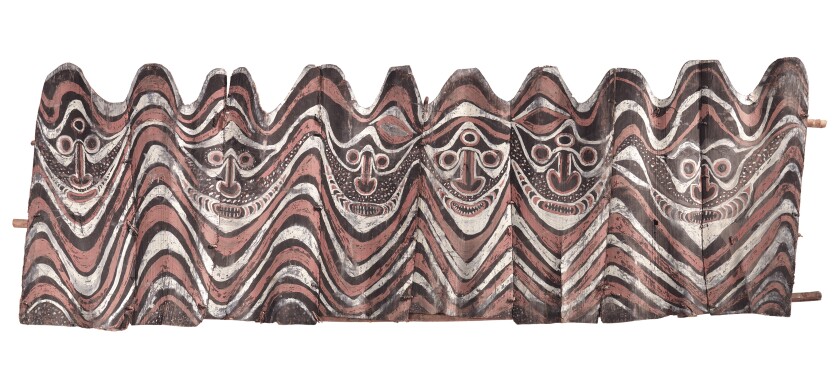
Artist unknown (Iatmul peoples, Papua New Guinea), ceremonial house painting, early or mid-20th century; painted wood
(UCLA Fowler Museum)
Iatmul peoples, Papua, New Guinea, ceremonial house painting, early to mid-20th century
In the origin story of the Iatmul peoples, who live along the Sepik River in Papua New Guinea, the world was a primal sea. The ancestral spirits who emerged from it to create the land and name the things of the world are represented among undulating waves in this series of painted wood panels, which once adorned the facade of a ceremonial house.
UCLA Fowler Museum, 308 Charles E. Young Drive N., 90024
For all the latest Entertainment News Click Here
For the latest news and updates, follow us on Google News.
